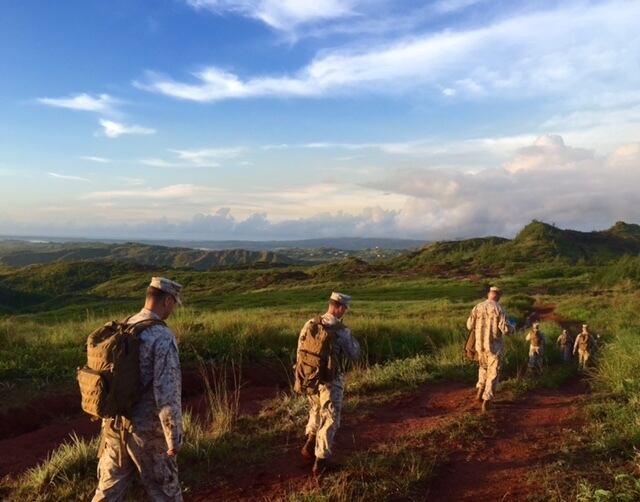One of the Marine Corps' oldest infantry regiments will be among the units moving from Japan to Guam over the next few years.
Members of 4th Marine Regiment, known as "The Oldest and the Proudest," along with 3rd Marine Expeditionary Brigade's command element will eventually be relocated to the Pacific island, said Chuck Little, a spokesman with Marine Corps Forces Pacific. Both units are currently based in Okinawa, Japan.
Aviation and logistics support enablers will also move to Guam, Little said.
Those moves will leave about 1,600 Marines permanently based on the U.S. territory in the western Pacific. Another 3,300 Marines will rotate through Guam as part of the Corps' unit deployment program, which currently sends U.S.-based units to Japan for six months at a time.
About 1,300 Marine dependents will also be based on Guam, Little said.
In late August, Navy officials signed off on the long-awaited Record of Decision authorizing the relocation of Marines and their families to Guam. The move is largely meant to reduce the Corps' presence in Okinawa, which will eventually be reduced to about 10,000 Marines.
That shift will be gradual, with the bulk of Marines and their family members slated to arrive in Guam in 2020. Those numbers will gradually increase each year through 2026, when the Corps plans to reach its target of 5,000 Marines and 1,300 dependents on the island, according to the Navy's plan.
Lt. Gen. John Toolan, MARFORPAC's commander, said operating from Guam provides the Marine Corps with a robust area where multinational training exercises can be held. Additionally, he said, it will allow Marines in the region to respond to crises quickly when time is critical, "whether in combat or natural disasters."
"The vast distances of the region necessitate that our Marines be forward-based and forward-deployed, ready to respond throughout Asia-Pacific," Toolan said.
Naval Facilities Engineering Command has released a proposal for the first construction project that will house the majority of Marines and their families on Guam, Toolan said. Marine families will live in housing at Andersen Air Force Base and bachelors' quarters will be built at a Navy facility on the north side of the island, according to the Navy's plan.

Guam gives the Corps a robust area where multinational training exercises can be held and where Marines can respond quickly to crises or natural disasters. Here, Marines from Marine Corps Activity Guam hike up to Mt. Tenjo, near Naval Base Guam.
Photo Credit: Lance Cpl. Jacob Snouffer/Marine Corps
Construction projects at Andersen are also ongoing, Toolan added, which will accommodate the Marine Corps' aviation combat element. A parking ramp that can hold 25 aircraft has been built while construction on hangars, an aircraft wash rack, fueling stations and other projects are in progress, he said.
The Navy Department has also made improvements at the wharf for visiting Navy ships that includes a welcome center for disembarking Marines, Toolan said. They'll soon start building new ranges, to include space for both live-fire qualifications and maneuver training, he said.
According to the Navy's plan, a 338-acre live-fire training range complex will be built at Andersen's Northwest Field and a hand-grenade range will be built at Andersen South.





